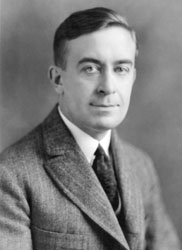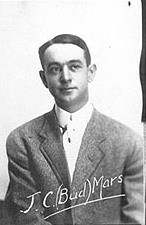
The NC-4 is a Curtiss NC flying boat that was the first aircraft to fly across the Atlantic Ocean, albeit not non-stop. The NC designation was derived from the collaborative efforts of the Navy (N) and Curtiss (C). The NC series flying boats were designed to meet wartime needs, and after the end of World War I they were sent overseas to validate the design concept.
This is a list of aviation-related events from 1910:

Didier Masson was a pioneering French aviator. He was born in Asnières, France. He died and was buried in Mérida, Yucatan, Mexico. Among his adventures was his life as a pioneering barnstormer, being the second flier in history to bomb a surface warship, as well as combat service in the Lafayette Escadrille with Edwin C. Parsons and Charles Nungesser. In one of the more unusual aerial victories of history, Masson shot down an enemy plane after his own plane's motor quit running. Later in life, he was a manager for pioneer Pan American World Airways, as well as a French consular officer.

Bertrand Blanchard Acosta was a record-setting aviator and test pilot. He and Clarence D. Chamberlin set an endurance record of 51 hours, 11 minutes, and 25 seconds in the air. He later flew in the Spanish Civil War in the Yankee Squadron. He was known as the "bad boy of the air". He received numerous fines and suspensions for flying stunts such as flying under bridges or flying too close to buildings.

Blanche Stuart Scott, also known as Betty Scott, was possibly the first American woman aviator. For her automobile journey across the United States she won the attention and admiration of pioneer aviator Glenn Curtiss who gave her flying lessons at the Curtiss flying school, in Hammondsport, New York, America's first flying school.

Lincoln Beachey was a pioneer American aviator and barnstormer. He became famous and wealthy from flying exhibitions, staging aerial stunts, helping invent aerobatics, and setting aviation records.

Charles Francis Walsh was an American pioneer aviator who died in a crash in Trenton, New Jersey.

The Aeronautical Division, Signal Corps (1907–1914) was the first heavier-than-air military aviation organization in history and the progenitor of the United States Air Force. A component of the U.S. Army Signal Corps, the Aeronautical Division procured the first powered military aircraft in 1909, created schools to train its aviators, and initiated a rating system for pilot qualifications. It organized and deployed the first permanent American aviation unit, the 1st Aero Squadron, in 1913. The Aeronautical Division trained 51 officers and 2 enlisted men as pilots, and incurred 13 fatalities in air crashes. During this period, the Aeronautical Division had 29 factory-built aircraft in its inventory, built a 30th from spare parts, and leased a civilian airplane for a short period in 1911.

Isidore Auguste Marie Louis Paulhan, was a French aviator. He is known for winning the first Daily Mail aviation prize for the first flight between London and Manchester in 1910.

The Curtiss Flying School was started by Glenn Curtiss to compete against the Wright Flying School of the Wright brothers. The first example was located in San Diego, California.

The Curtiss Models F made up a family of early flying boats developed in the United States in the years leading up to World War I. Widely produced, Model Fs saw service with the United States Navy under the designations C-2 through C-5, later reclassified to AB-2 through AB-5. Several examples were exported to Russia, and the type was built under license in Italy.

Joseph Marie Pallissard also known as Caproni-Joe, was a pioneer aviator.

Alfred Victor Verville was an American aviation pioneer and aircraft designer who contributed to civilian and military aviation. During his forty-seven years in the aviation industry, he was responsible for the design and development of nearly twenty commercial and military airplanes. Verville is known for designing flying boats, military racing airplanes, and a series of commercial cabin airplanes. His planes were awarded with the Pulitzer Speed Classic Trophy in 1920 and 1924.

Logan Archbold "Jack" Vilas was an aviation pioneer and a member of the Early Birds of Aviation. He was inducted into the Wisconsin Aviation Hall of Fame in 2000.

James Cairn Mars, also known Bud Mars and the Curtiss Daredevil, was an aviation pioneer. He was the eleventh pilot licensed in the United States. As a balloonist, he was a student of Thomas Scott Baldwin, and as an airplane pilot, of Glenn Curtiss.

Charles Keeney Hamilton was an American pioneer aviator nicknamed the "crazy man of the air". He was, in the words of the U.S. Centennial of Flight Commission, "known for his dangerous dives, spectacular crashes, extensive reconstructive surgeries, and ever present cigarette" and was "frequently drunk". He survived more than 60 crashes.
Several aviators have been claimed to be the first to fly a powered aeroplane. Much controversy surrounds these claims. It is generally accepted today that the Wright brothers were the first to achieve sustained and controlled powered manned flight, in 1903. It is popularly held in Brazil that their native citizen Alberto Santos-Dumont was the first successful aviator, discounting the Wright brothers' claim because their Flyer took off from a rail, and in later flights would sometimes employ a catapult. An editorial in the 2013 edition of Jane's All the World's Aircraft supported the claim of Gustave Whitehead. Claims by, or on behalf of, other pioneers such as Clément Ader have also been put forward from time to time.

Curtiss LaQ Day Jr. was an American aviator during the pioneer era. Throughout his teenage and young adult life, Day constructed planes, created a company, flew in exhibitions, taught at prominent aviation schools, and served in the United States military before leaving the field in the mid 1920s. He was once said to be youngest person in the United States to hold a pilot's license from the Aero Club of America.

Edgar Wirt Bagnell was a pioneer aviator who was a member of the Early Birds of Aviation.

David Hugh McCulloch was an early American aviator who worked with Glenn Curtiss from 1912. Curtiss was a contemporary and competitor to the Wright brothers, Wilbur and Orville, who had made the first flights at Kitty Hawk in 1903. Curtiss won the world's first air race at Reims in France in August 1909, and was now becoming the driving force in American aviation. McCulloch's early work with Curtiss consisted of demonstrating, training and selling Curtiss planes and participating in early developments of flight. He trained the First Yale Unit, and in two consecutive days in 1917, he and several of his pupils from the First Yale Unit made flights that convinced the Navy to bring aircraft aboard ships. Later, McCulloch was co-pilot with Holden C. Richardson and flight commander John Henry Towers of the NC-3, the leader of the three Navy flying boats making the first flight across the Atlantic Ocean.


















